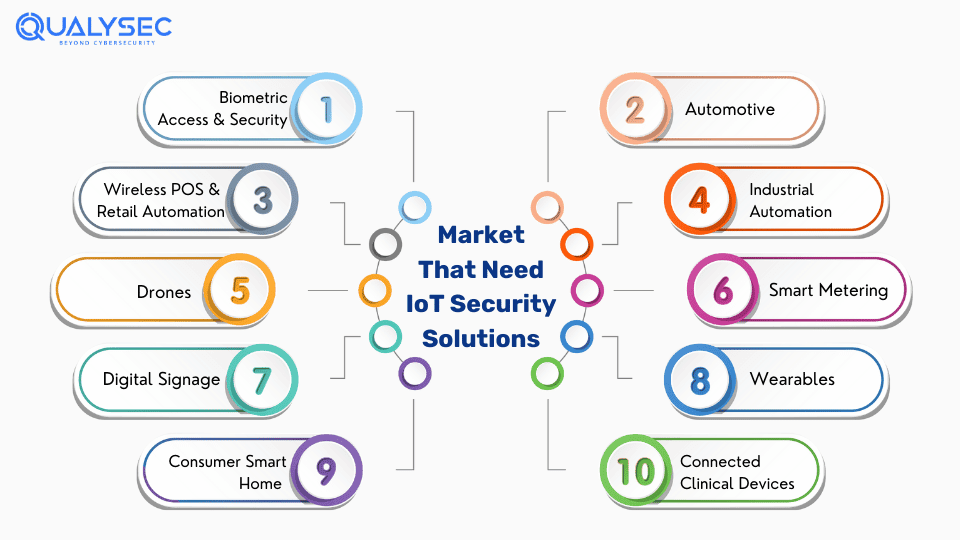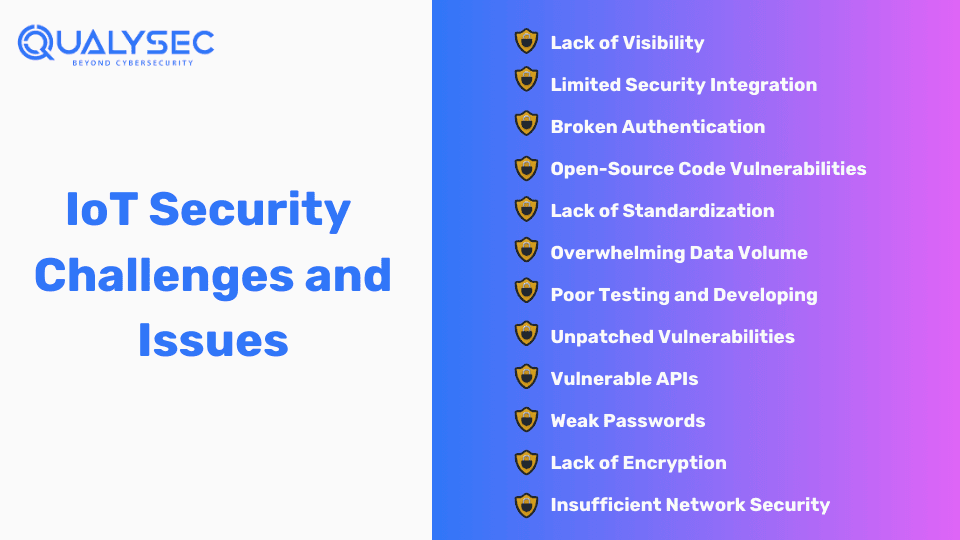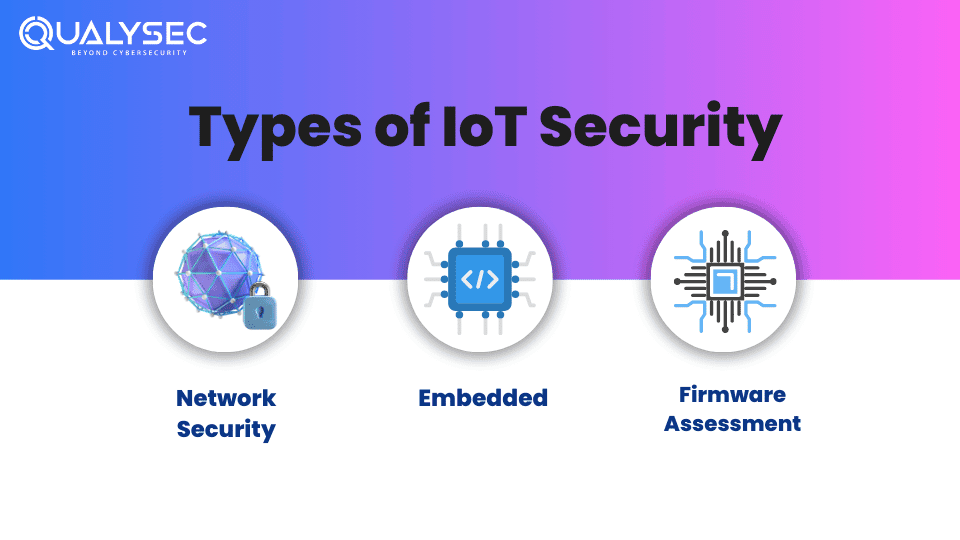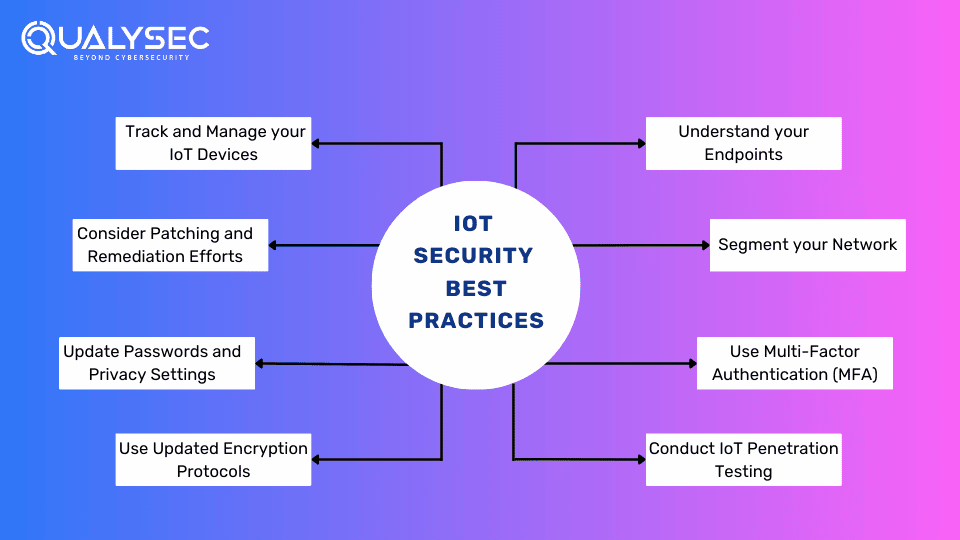IoT Security or Internet of Things Security is a cybersecurity practice to protect IoT devices and their networks from cyber threats. Some commonly used IoT devices include smart home devices, smart watches, smart door locks, networked security cameras, autonomous connected cars, voice control devices, smart healthcare devices, etc.
Since IoT devices store and transfer data over the internet, IoT security is needed to help prevent data breaches. IoT devices have no built-in security, which is why companies need to give extra priority to their security.
| In 2022, over 112 million attacks were reported on IoT devices. |
Along with understanding IoT security, it is essential to know the many challenges enterprises face while dealing with IoT security issues. This blog covers all the important aspects of IoT security, so stay till the end.

What is IoT Security?
IoT security is basically the strategies and procedures to defend IoT devices and the vulnerable networks they are linked with. Its main goal is to keep the user data safe, prevent cyberattacks, and keep the device running smoothly.
Common IoT security practices include:
-
- Data encryption protocols
-
- Strong authentication mechanisms
Anything that is connected to the internet is prone to cyberattacks. Hackers use a variety of methods to compromise IoT devices. Once they are successful, they can steal confidential data or attempt to compromise the rest of the connected network and devices.
IoT devices are slowly becoming a part of our everyday lives, and both consumers and makers may face a lot of IoT security challenges. IoT is very broad and as technology evolves, it is going to be broader. From watches and video game consoles to crucial business equipment, nearly every field is using (or going to use) IoT devices. This is both exciting and threatening, given the chances of cyberattacks. As a result, it is of utmost necessity to prioritize IoT security.
IoT Security Challenges and Issues

As said earlier, IoT devices are not made with security in mind. As a result, there are a myriad of IoT security challenges that can lead to disastrous situations. Unlike many other technology solutions, few rules and standards are in place to direct IoT security. Additionally, most people do not understand the inherent risks associated with IoT devices, nor do they have any idea of these security challenges.
Among the many IoT security challenges and issues, here are twelve crucial ones:
1. Lack of Visibility
Users often deploy IoT devices without the knowledge of IT departments. This makes it impossible to maintain an accurate inventory of the devices that need protection and monitoring. Without a clear understanding of what devices are connected to the network, it becomes difficult to implement comprehensive security measures.
2. Limited Security Integration
Due to the vast variety and scale of IoT devices, integrating them into existing security systems is challenging and sometimes impossible. Each device might require different security protocols and standards, making it hard to create a unified security strategy.
3. Broken Authentication
Weak or broken authentication methods are common in IoT devices. This allows unauthorized users to gain access to sensitive data. Strong authentication mechanisms are necessary to verify the identity of users and protect the devices from unauthorized access.
4. Open-Source Code Vulnerabilities
Firmware developed for IoT devices usually includes open-source software, which is prone to bugs and vulnerabilities. These vulnerabilities can be exploited by attackers if they are not identified and patched timely, putting the entire network at risk.
5. Lack of Standardization
Lack of standardization means the absence of certain specifications and protocols that are agreed upon. This can result in different product systems or devices that are not compatible with each other. In IoT devices, it can cause difficulties in communication and data exchange between multiple devices.
6. Overwhelming Data Volume
The massive amount of data generated by IoT devices complicates data oversight, management, and protection. Handling this data requires robust systems that are capable of processing and securing large volumes of information efficiently.
| You Might Like: Top Cloud Security Challenges |
7. Poor Testing and Developing
Because most IoT developers do not prioritize security, they fail to perform effective vulnerability testing. As a result, potential weaknesses in IoT systems remain undiscovered, leaving them exposed to cyber threats.
8. Unpatched Vulnerabilities
Many IoT devices have unpatched vulnerabilities due to various reasons, including the unavailability of patches and difficulties in accessing and installing them. These unpatched flaws can be exploited by cybercriminals, leading to security breaches.
9. Vulnerable APIs
APIs are often used as entry points for cyberattacks, such as SQL injection, distributed denial of service (DDoS), and network breaches. Weak API security can provide attackers with control over IoT devices and access to sensitive data.
10. Weak Passwords
IoT devices are usually shipped with default passwords that many users fail to change, providing easy access for cybercriminals. Additionally, users often create weak passwords that can be easily guessed, further compromising device security.
11. Lack of Encryption
While encryption is a major security practice, it can also be a challenge. Many IoT devices do not use encryption to protect data during transmission, making it easier for attackers to intercept and exploit sensitive information. Encryption is essential for ensuring data privacy and security.
12. Insufficient Network Security
IoT devices often connect to networks without proper security measures, making the entire network vulnerable to attacks. Implementing robust network security is crucial to protect connected devices and the data they handle.
Types of IoT Security

IoT security solutions can be implemented by both the users and makers. There are basically three types of IoT security, such as:
1. Network Security
Users should protect their devices against unauthorized access and potential exploitation. Therefore, IoT network security implements a zero-trust security strategy to minimize the corporate attack surface. This approach assumes no device or user is trusted by default and requires continuous verification of all connections and activities.
2. Embedded
Nano agents provide on-device security for IoT systems. These agents offer lightweight, yet effective security measures tailored for the limited resources of IoT devices. Runtime protection monitors the current state of the device and takes action based on abnormalities to identify and remediate zero-day attacks. This ensures ongoing protection against emerging threats.
3. Firmware Assessment
Firmware security begins with assessing the firmware of a protected IoT device. This process involves analyzing the code and configuration of the firmware to find potential vulnerabilities. By identifying weaknesses early, firmware security helps prevent exploitation and enhances the overall security posture of the IoT ecosystem.
Our experts at Qualysec have helped secure fintech, SaaS, and enterprise systems across 25+ countries. Manual + Automated Pentesting. No false positives. Actionable reports.

5 Examples of IoT Security Breaches
Hackers can breach and launch attacks on millions of unprotected IoT devices. They can steal data, take down networks, or destroy the IT infrastructure. Here are some of the biggest cyberattacks on IoT devices:
2010 – The Stuxnet Attack
Stuxnet is one of the most well-known IoT attacks, which targeted a uranium enrichment plant in Natanz, Iran. The attack compromised Siemens Step7 software on Windows, allowing the worm to control industrial program logic controllers. This allowed the attackers to manipulate machinery and access critical industrial data.
The first signs of trouble appeared in 2010 when IAEA inspectors noticed an unusually high failure rate in the plant’s uranium enrichment centrifuges. Later that year, multiple malicious files, including the Stuxnet worms were discovered on Iranian computer systems.
Although Iran has not detailed the attack’s impact, Stuxnet is believed to have damaged 984 centrifuges, reducing enrichment efficiency by an estimated 30%.
2012 – The TRENDnet Webcam Hack
TRENDnet marketed their SecurView cameras as versatile solutions for home security and baby monitoring, promising strong security features. However, it was discovered that these cameras were easily accessible to anyone who could find their IP addresses, allowing unauthorized viewing and, in some cases, audio capture.
The FTC revealed that TRENDnet had been transmitting users’ login details over the internet without encryption, making them vulnerable to interception. This incident serves as a reminder not to assume devices labeled as secure are infallible.
2016 – The Mirai Botnet Attack
In October 2016, an IoT botnet (a network of computers that run on bots) carried out a major DDoS attack on Dyn, an Internet performance management company, causing major websites like CNN, Netflix, and Twitter to go offline.
The Mirai malware was responsible for this attack. Infected computers scanned the internet for vulnerable IoT devices, such as digital cameras and DVR players, and infected them by using default usernames and passwords.
2020 – Tesla Model X Hack
A cybersecurity expert hacked a Tesla Model X in under two minutes by exploiting a vulnerability in its Bluetooth system. This incident highlighted a broader issue, where other vehicles that use wireless keys for entry and ignition have also faced similar security breaches.
2021 – The Verkada Hack
In March 2021, Verkada, a cloud-based video surveillance company, was hacked. The attackers used legitimate admin credentials found online to access the private information of Verkada’s clients and live feeds from over 150,000 cameras in various locations like factories, hospitals, schools, and prisons.
It was later discovered that over 100 Verkada employees had “super admin” privileges, allowing them to access thousands of customer cameras, highlighting the dangers of excessive user privileges.
IoT Security Best Practices

Securing IoT devices is critical, but it requires robust security measures to keep sensitive data from falling into the wrong hands. Using zero-trust network access adds an extra layer of security. Here are eight best IoT security practices that can save data in transit and at rest:
1. Track and Manage your IoT Devices
It can be challenging to manage devices across an organization without understanding how each device works and operates. Knowing the connected devices in your organization is the first step to securing your IoT infrastructure. To effectively manage IoT devices, consider using continuous monitoring software. This software can help you monitor, discover, track, and manage devices, enhancing your organization’s security against future attacks.
2. Consider Patching and Remediation Efforts
Patching and remediation involve updating the code of connected devices to maintain optimal security. Before deploying a networked device, organizations should determine if the device can be updated over time to address evolving threats. Some devices have limited capabilities or are too complex to patch thoroughly. Thus, it’s crucial to consider remediation strategies before integrating a new IoT device into your network.
3. Update Passwords and Privacy Settings
Although updating passwords might seem like an outdated practice, many devices still come with vendor-supplied default passwords and privacy settings. Cybercriminals can easily find and exploit these default passwords to gain control of IoT devices. Regularly updating passwords and privacy settings is a crucial step in maintaining the security of your devices.
4. Use Updated Encryption Protocols
Unencrypted data enables cybercriminals to access sensitive information or listen to network communications. To protect against IoT threats, organizations should encrypt all data within their network. Implementing up-to-date encryption protocols ensures that data remains unreadable to unauthorized users. This significantly enhances IoT security.
| Also Read: Top 10 IoT Security Companies |
5. Understand your Endpoints
Connecting a new IoT device adds a new endpoint to the network, such as laptops, smartphones, cloud servers, and printers. Each endpoint can be a potential entry point for cybercriminals. To maintain a secure network, organizations should identify and profile all IoT endpoints. Using endpoint security tools that offer antivirus protection, mobile device management, security patch updates, and data encryption can help improve overall security.
6. Segment your Network
When adding IoT devices to your network, assume they could be hacked so that you’re well prepared for potential breaches. Using network segmentation can help protect your organization during a cyberattack by dividing the network into smaller sub-networks. This limits unauthorized access, preventing attackers from moving from one sub-network to another and reducing access points to sensitive data.
7. Use Multi-Factor Authentication (MFA)
Multi-factor authentication (MFA) goes beyond traditional two-factor authentication by requiring two or more verification factors to access a device. This means users must complete multiple authentication steps to access an IoT device, thus enhancing overall security and providing an additional layer of protection against cyberattacks.
8. Conduct IoT Penetration Testing
IoT penetration testing is the process of evaluating the security defenses of IoT devices against cyber threats. It identifies vulnerabilities, security policies, regulatory compliance, risk response, and more. Additionally, its report provides remediation methods to fix the vulnerabilities present. Conducting regular pen tests is probably the best way to strengthen IoT security and prevent potential attacks.
Want to perform IoT penetration Testing? We provide hybrid process-based penetration testing services that can find hidden vulnerabilities in your IoT infrastructure. Tap the link below and talk to our pen test expert!
Talk to our Cybersecurity Expert to discuss your specific needs and how we can help your business.
Conclusion
Internet of Things (IoT) and inter-connected devices have become a critical component of many organizational operations and even a user’s life. However, as these devices become more embedded, their security risk keeps on growing related to the data and other devices on its network. With more innovative connected devices to be generated in the future, IoT security should now be a top priority for manufacturers.
Understand the challenges behind IoT security and implement the best practices mentioned above. Additionally, partner with Qualysec to get the best IoT penetration testing services with accurate results. The security of your IoT devices and their network now lies in your hands!
FAQs
Q: What is an example of IoT security?
A: Internet of Things (IoT) devices are computerized internet-connected objects/systems such as smart home devices, automated cars, networked security cameras, etc. Common IoT security includes data encryption, multi-factor authentication, and IoT penetration testing.
Q: What are the security requirements in IoT?
A: The main security requirements of IoT are:
-
- Ensuring the confidentiality and integrity of data shared between connected devices
-
- Ensure the data is not tampered with during the sharing
-
- Providing each IoT device with a verifiable identity (through digital signatures or certificates)
Q: Why do we need IoT security?
A: IoT security is important due to the growing use of IoT devices, and the data stored within them. IoT devices do not come with a built-in security system and data encryption. Therefore, it allows hackers to compromise the device and gain unauthorized access.
Q: What is IoT security protocols?
A: Internet protocol (IP) is a set of rules that dictates how data migrates to the Internet. IoT protocols ensure that information from one device is understood by another connected device. Therefore, different IoT protocols are designed and optimized for different usage and scenarios.






























































































































































































































































































































































































































































































































0 Comments